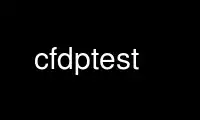
This is the command cfdptest that can be run in the OnWorks free hosting provider using one of our multiple free online workstations such as Ubuntu Online, Fedora Online, Windows online emulator or MAC OS online emulator
PROGRAM:
NAME
cfdptest - CFDP test shell for ION
SYNOPSIS
cfdptest [ commands_filename ]
DESCRIPTION
cfdptest provides a mechanism for testing CFDP file transmission. It can be used in
either scripted or interactive mode. All bundles containing CFDP PDUs are sent with
custody transfer requested and with all bundle status reporting disabled.
When scripted with commands_filename, cfdptest operates in response to CFDP management
commands contained in the provided commands file. Each line of text in the file is
interpreted as a single command comprising several tokens: a one-character command code
and, in most cases, one or more command arguments of one or more characters. The commands
configure and initiate CFDP file transmission operations.
If no file is specified, cfdptest instead offers the user an interactive "shell" for
command entry. cfdptest prints a prompt string (": ") to stdout, accepts strings of text
from stdin, and interprets each string as a command.
The supported cfdptest commands (whether interactive or scripted) are as follows:
? The help command. This will display a listing of the commands and their formats. It
is the same as the h command.
h An alternate form of the help command.
d <destination CFDP entity ID number>
The destination command. This command establishes the CFDP entity to which the next
file transmission operation will be directed. CFDP entity numbers in ION are, by
convention, the same as BP node numbers.
f <source file path name>
The from command. This command identifies the file that will be transmitted when the
next file transmission operation is commanded.
t <destination file path name>
The to command. This command provides the name for the file that will be created at
the receiving entity when the next file transmission operation is commanded.
l <lifetime in seconds>
The time-to-live command. This command establishes the time-to-live for all
subsequently issued bundles containing CFDP PDUs. If not specified, the default value
86400 (1 day) is used.
p <priority>
The priority command. This command establishes the priority (class of service) for
all subsequently issued bundles containing CFDP PDUs. Valid values are 0, 1, and 2.
If not specified, priority is 1.
o <ordinal>
The ordinal command. This command establishes the "ordinal" (sub-priority within
priority 2) for all subsequently issued bundles containing CFDP PDUs. Valid values
are 0-254. If not specified, ordinal is 0.
m <mode>
The mode command. This command establishes the transmission mode ("best-effort" or
assured) for all subsequently issued bundles containing CFDP PDUs. Valid values are 0
(assured, reliable, with reliability provided by a reliable DTN convergence layer
protocol), 1 (best-effort, unreliable), and 2 (assured, reliable, but with reliability
provided by BP custody transfer). If not specified, transmission mode is 0.
g <srrflags>
The srrflags command. This command establishes the BP status reporting that will be
requested for all subsequently issued bundles containing CFDP PDUs. srrflags must be
a status reporting flags string as defined for bptrace(1): a sequence of status report
flags, separated by commas, with no embedded whitespace. Each status report flag must
be one of the following: rcv, ct, fwd, dlv, del.
c <criticality>
The criticality command. This command establishes the criticality for all
subsequently issued bundles containing CFDP PDUs. Valid values are 0 (not critical)
and 1 (critical). If not specified, criticality is 0.
r <action code nbr> <first path name> <second path name>
The filestore request command. This command adds a filestore request to the metadata
that will be issued when the next file transmission operation is commanded. Action
code numbers are:
0 = create file
1 = delete file
2 = rename file
3 = append file
4 = replace file
5 = create directory
6 = remove directory
7 = deny file
8 = deny directory
u '<message text>'
The user message command. This command adds a user message to the metadata that will
be issued when the next file transmission operation is commanded.
& The send command. This command initiates file transmission as configured by the most
recent preceding d, f, and t commands.
^ The cancel command. This command cancels the most recently initiated file
transmission.
% The suspend command. This command suspends the most recently initiated file
transmission.
$ The resume command. This command resumes the most recently initiated file
transmission.
# The report command. This command reports on the most recently initiated file
transmission.
q The quit command. Terminates the cfdptest program.
cfdptest in interactive mode also spawns a CFDP event handling thread. The event thread
receives CFDP service indications and simply prints lines of text to stdout to announce
them.
NOTE that when cfdptest runs in scripted mode it does not spawn an event handling thread,
which makes it possible for the CFDP events queue to grow indefinitely unless some other
task consumes and reports on the events. One simple solution is to run an interactive
cfdptest task in background, simply to keep the event queue cleared, while scripted non-
interactive cfdptest tasks are run in the foreground.
EXIT STATUS
"0" cfdptest has terminated. Any problems encountered during operation will be noted in
the ion.log log file.
Use cfdptest online using onworks.net services
